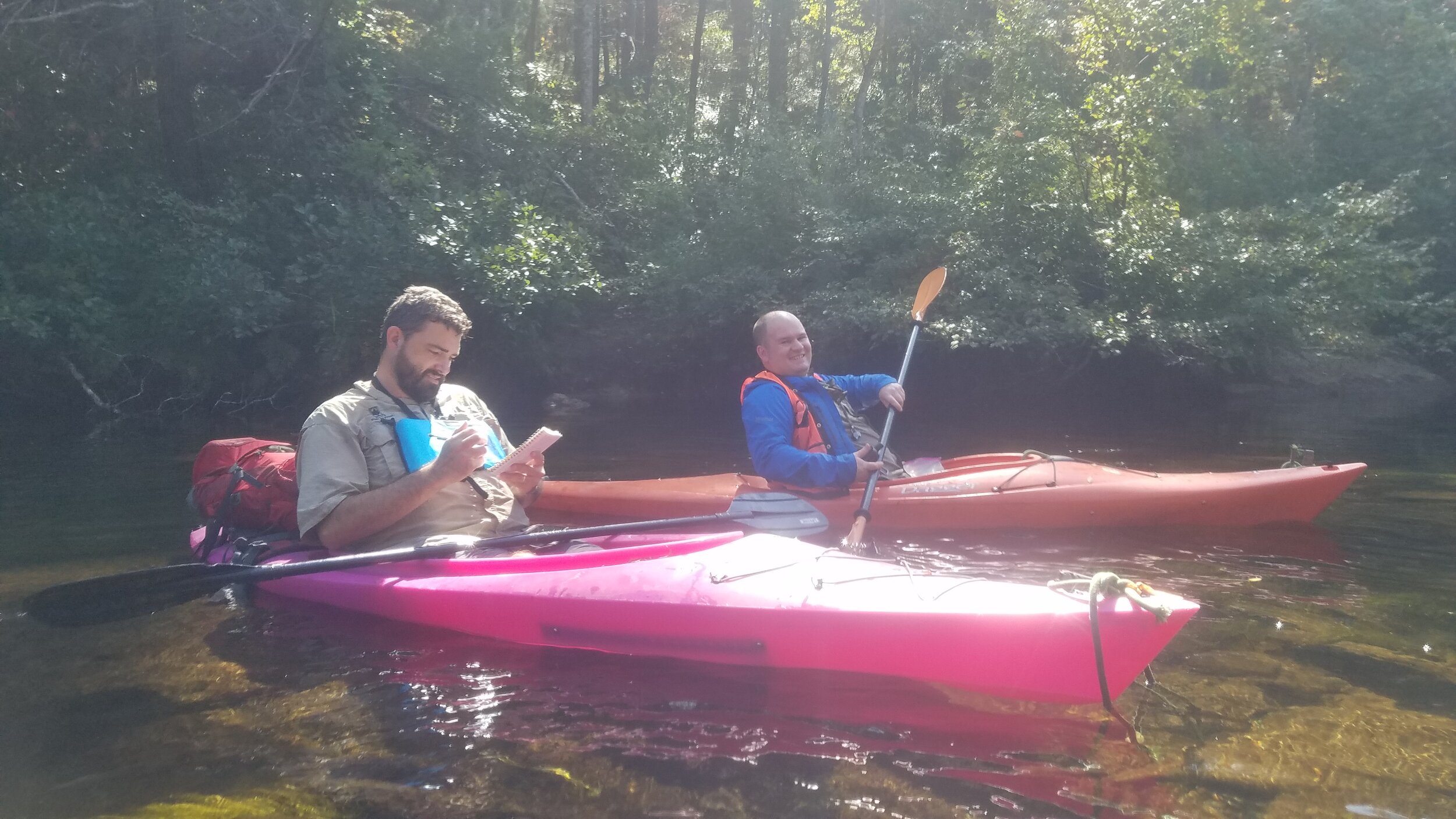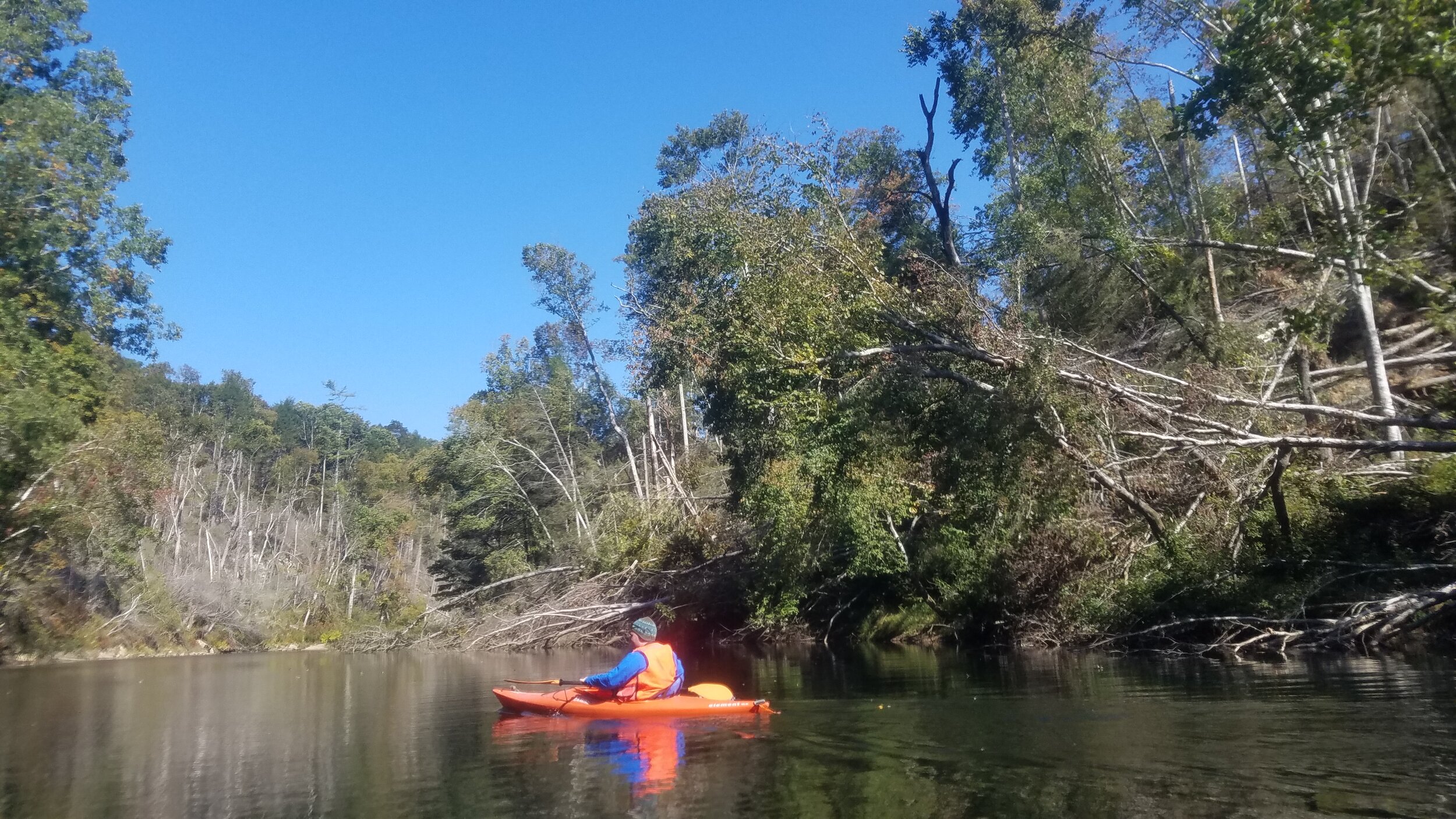By Dwayne Estes, SGI Executive Director
Michelle McInnis
Michelle McInnis is one of my graduate students and has been an SGI team member since the beginning of 2019. For her thesis she is studying the riverscour barrens of Clear Creek, part of the Obed Wild and Scenic River, a division of the National Park Service. She has the arduous task of exploring about 10-15 miles of remote, rugged river gorge terrain, visiting the entire length of the river. When she signed up, I don’t think she anticipated that river rescues would be part of her job!
During the course of her thesis Michelle is exploring the whole river, setting up Carolina Vegetation Survey plots to collect data on riverscour communities, completing a full floristic inventory, mapping rare species (with Zach Irick’s help), and documenting everything with herbarium specimens and iNaturalist, see it here.
Clear Creek portion of the Obed Wild and Scenic River
On Wednesday, October 7, 2020, the three of us explored a 4.5 mile section of Clear Creek Gorge (see pic below). This is a beautiful section of river. Our work there has two main aspects, one led by Michelle and one by Zach. Michelle is leading the riverscour study part and Zach, as part of a contract with National Park Service, is surveying the river for aquatic native plant beds (not grasslands per se but helps fund exploration of the river which puts us in contact with the riverscour).
Riverscour grasslands at Clear Creek
Why riverscour can be treacherous
Riverscour is extremely treacherous and requires a high degree of planning due to the rugged nature of the terrain and the changing water levels. Michelle really showed that she is doing great work on our excursion together because not only did she plan for her own needs but she ended up having to help me!
I, the veteran of riverscour exploration, totally misjudged this trip. I did what I have lectured my other grad students and team members not to do: I underestimated the scours!! Fortunately, Michelle and Zach provided great company, and Michelle in particular helped lead us out of the river in the dark!
We began our day by meeting at 8:00 a.m. We had not done this stretch of river, and one thing I have learned by now is that each river reach is very different and often hard to plan for.
Because there are a lot of long, deep pools we thought it best to use kayaks even though the flow rate was 9 cfs (cubic feet per second), which is very low. We were aware that this low flow would probably mean we'd have to drag our kayaks many times, and that's always a risk. We dragged alright and we ended up having to portage probably 50 times! Basically every riffle or rapid was impassable, requiring us to get out of the kayaks and drag them over many meters at times.
Dwayne Estes and Zach Irick botanizing by kayak in Clear Creek river gorge, October 2020.
Documenting a riverscour barren and aquatic flora
Early on in the trip we found a great riverscour barren and got out to set up a 100 sq-meter veg plot. Michelle will be collecting data from probably. 8-12 plots as part of her study. It was pretty diverse with about 47-48 species and no exotics that I recall. It had rare species such as the federally-threatened Cumberland Rosemary (Conradina verticillata), Black Warrior Goldenrod (Solidago arenicola) and a couple of undescribed species (an aster and a ligusticum) that we've known about now for a long time.
Michelle's study adds to a series of riverscour projects that we have been working on since 2013, building on the work of Zach at Little River Canyon, Alabama, Devin Rodgers of Daddy's Creek, Chris Mausert-Mooney of Big South Fork, Mason Brock of Caney Fork, and Kelly Anderson of Locust Fork of Warrior River in Alabama. Theo Witsell and I are working with the Natural Areas Association now to publish a special journal issue focused on riverscour of eastern unglaciated North America.
After setting up our plot, we switched our focus to working with Zach to document the aquatic zones of the river (again this is what is paying for our work). We are mapping the river, documenting where pools, runs, and riffles are and documenting the aquatic flora of each zone.
This river has one of the richest aquatic floras in the Southeast and is home to rare species like the Tennessee Pondweed (Potamogeton tennesseensis, P. amplifolius). We are combining our survey with previously completed riverbed mapping and GIS work which will involve modeling the river to see how native aquatic beds relate to rare aquatic animal habitat and how these beds of aquatics will be impacted in future years if and when the river is invaded by the invasive plant, Hydrilla verticillata. Previous research by us has shown that that invasive has invaded a nearby river, and it is only a matter of time before it gets into Clear Creek.
We were having great success with mapping large beds of aquatics and began to realize that time was getting short, and progress getting downriver quickly had been impeded by all of the portages.
It’s 2020 on Clear Creek River, what could go wrong?
Just then, I realized that I had dropped my iPhone in the river somewhere behind us upstream. With the declining light, weight of my waterlogged backpack, and dragging the kayak, I was getting rushed in my own head and started making mistakes. We paused, and Michelle hiked back upriver a ways searching for my phone, followed by Zach and me. This meant a lot that they helped me even though we couldn't really afford the extra time due to my carelessness. With the loss of my phone we lost about 300-400 pictures and a dozen video clips that I had taken to document the day's activities.
There went a bunch of fun iNat observations.
Frustrated and tired, I admired how Michelle showed real leadership by reminding us to stop and rehydrate and offering us help as needed. As night was about to fall, we realized we still had a couple of miles to go, and I began falling.
I fell 3 times within an hour. The first time I fell flat on my back after stepping on slick rocks and if I had not had a backpack on to break my fall I would have definitely injured my back or head. I almost broke my left middle finger but Zach helped me up, and I brushed it off.
My next fall almost did me in. You know, I kind of think that at 6 ft 3 inches tall I’d be able to see the ground coming if I fell from that height. Well, I almost found out the hard way how quickly your face can meet rock! I came the closest I've ever come to smacking my face on a head-sized boulder. Somehow, my right hand came up just in time to break my right cheekbone from striking rock. I'm certain I would have had a head injury or broken jaw bone if my hand had not been in the way.
Fighting embarrassment, exhaustion, and fading light, I struggled a bit to regain my composure and pull my own weight. I was frustrated that I had let myself become rusty with fieldwork. I felt under-prepared and was especially frustrated that I had not thought to pack emergency gear or even a head lamp.
As darkness neared, Michelle grabbed my 30 lb backpack and strapped it to her kayak and graciously dragged that extra weight. It was a big relief, and something she didn't have to do, but she showed real leadership and teamwork in doing so. I felt a bit embarrassed that I was putting her out, but she continued to insist that it was not a burden. I am grateful to her because it helped me regain my energy. Thank you, Michelle.
With darkness, we faced continued portages. Michelle led the way and Zach followed behind me. She would look back frequently to make sure I had light and Zach shined his light forward so I had the benefit of lighting from both of them.
Both of them were prepared. I was not.
Thank you Michelle and Zach for supporting me.
Moments that add up to unforgettable connections
Together, as a team, we relaxed and began to embrace the moment. Under full darkness we slowed our pace and continued downstream, hiking through unpassable boulder piles, dragging our kayaks with ropes (that I gratefully saw Zach had thought to bring). We stopped after paddling across an immense pool to see a rare arrowhead in flower (Sagittaria platyphylla). This Coastal Plain species is out of place in this mountain gorge. It was an unforgettable picture seeing Michelle and Zach's silhouettes working separately from their respective glows along the shoreline.
Now we had about a mile of river to still work down, we paddled in the darkness, and the stars above and Milky Way were amazing in the dark moonless sky. We all very much enjoyed the moment.
Finally, we were approaching our takeout where we seemed to encounter endless portage obstacles. But we finally arrived, and all of us kept up a cheery spirit, having thoroughly worn ourselves out but also having thoroughly enjoyed each other’s company.
We accomplished a lot that day, in spite of having to stop collecting data half-way through. We also accomplished something that is intangible. We grew as a team. Our relationships were strengthened. We needed this at a time when we've become disconnected due to Covid.
So, I want to thank Michelle especially for her leadership, great planning, team spirit, can-do attitude, and for helping me multiple times in multiple ways. Great work, Michelle, and we are very glad you are on our team.
I also want to thank Zach for his leadership, planning, and help. Seeing him in action as our new Southern Appalachian Coordinator is always so validating.
Paddle on!











